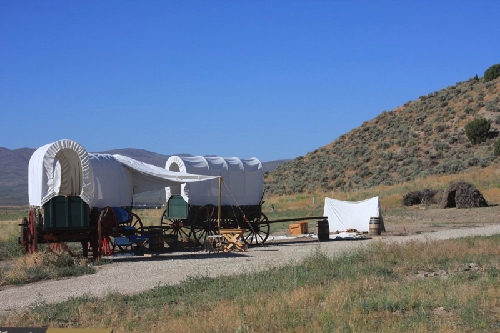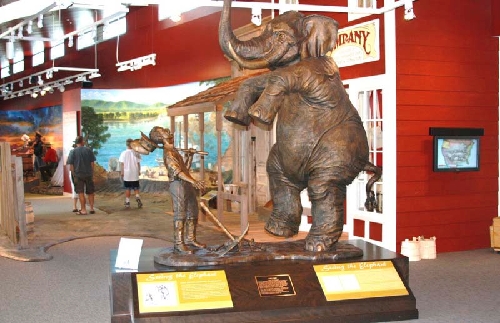Cerca: California Trail Center offers glimpse of pioneer experience
One bright May morning in 1841, 21-year-old John Bidwell saddled his horse, climbed aboard and trotted to the front of a heavily loaded wagon train in Independence, Mo. The sky was robin's-egg blue, the spring winds gentle and Bidwell's arrival stirred the air with an electric promise.
From atop his mount, the expectant young schoolteacher, principal and natural-born leader turned to face 69 fervent and indomitable men, women and children accompanying the wagons. With a wave of his hand and an enthusiastic "Wagons ho, " Bidwell started the train slowly creaking toward California, changing the face and destiny of America forever.
Although none of the wagons that started with Bidwell that spring and only 39 of his fellow travelers actually reached the Golden State, he is credited with leading the first major train of hundreds of others that would eventually carry more than 250,000 emigrants from Missouri River crossings and points east to California, a new land of promise.
From 1841 to 1869, when the Transcontinental Railroad was completed, their slow, plodding and relentless passage would carve deep swales in the earth that would eventually be called the California Trail. Though most of the trail has been erased by Mother Nature, modern vehicles and construction projects, there are parts that are pristine, relatively untouched since the last emigrant slowly trudged west.
To commemorate the trail and its importance to America, the California Trail Interpretive Center was constructed about 8 miles west of Elko on Interstate 80 some 430 miles north of Las Vegas. Parts of the trail are on public lands and are still evident near the interpretive center.
The center is the result of the hard work and dedication of several Elko groups and residents who lobbied for the California Trail Interpretive Act of 2000, whose approval authorized the facility, according to Gary Koy, Bureau of Land Management supervisory park ranger.
The 16,000-square-foot steel, glass and concrete center was finished in 2008; however, it wasn't until 2010 that the public began visiting and using the building for activities. And it wasn't until this spring that the center fully opened with several permanent exhibits and at least five traveling exhibits.
The grand opening is scheduled for Saturday, after the last three permanent exhibits are completely installed, explained Suzanne M. Miller, interpretive specialist at the center.
Koy said the significance of the trail can not be overstated.
" The California Trail facilitated the settlement of a large portion of the western United States, fostered commerce and encouraged the development of a transportation and communications network that brought the country closer," Koy said, citing BLM literature. But while the trail helped open the West to settlement, conversely, it also dramatically affected Native American culture, resulting in the loss of much of their land and resources.
" The California Trail experience was not just a formative period in the history of the U.S.," Koy said. "It is, arguably, the formative event in the development of the American personality and culture. The California Trail story is the story of individuals and families making very personal decisions to leave their homes, perhaps never to return, and travel to an unknown place. The fact that we are here today and the U.S. exists from 'sea to shining sea' is testament to the success of these individuals and families."
In addition to the building, the interpretive center is surrounded by a 15,000-square-foot plaza, about a mile of hiking trails, a small wagon encampment and a couple of Shoshone wickiups made from fragrant sagebrush branches.
The plaza was constructed with various size paving stones and is inlaid with a representative California Trail that "in scale, is very close to being accurate east to west, but slightly compressed north to south," Koy said.
The larger-than-life exhibits inside the center demonstrate some of the incredible hardships travelers had to endure while traversing the California Trail, including the harsh and unforgiving Great Salt Lake Desert. The exhibit shows the scorching, vast expanse of white salt and sand that claimed the lives of many would-be California settlers, much livestock and oftentimes tons of household goods that had to be discarded so wagons would be light enough to continue west.
Another exhibit hall is dominated by a massive bronze elephant that commemorates the phrase "Seeing the elephant." It was used by the emigrants to characterize their encounters with all the hardships they met while on the trail.
The expression was originally used in the 1820s, but overlanders adopted it to symbolize their travels. If a person had "seen the elephant," he or she had seen just about all there was to see and was still alive to tell about it.
Several of the exhibits are interactive and give visitors a hands-on experience with the past. Among other things, there are trunks of clothing that guests can don as they wander about the center rubbing shoulders with hand-made figures of pioneers from a bygone age.
A traveling exhibit titled "Gum San: Land of the Golden Mountain" describes through displays the lives of Chinese immigrants in the American West.
Upcoming permanent exhibits include the 1849 Gold Rush, the Donner Party disaster and a Great Basin Room that will be devoted to Native Americans from the Great Basin area, including the Shoshone, Washoe and Northern Paiute tribes, Koy said.
Listening stations throughout the center will help tell the story, Koy added.
"Visitors will be able to listen as actors read from the personal diaries of the pioneers describing in their own words everything they went through."
Outside, gazing south across Interstate 80 from the open courtyard in front of the center, a meandering bend of the Humboldt River can be seen, the same lazy bend that a hot, tired pioneer might have seen while resting from the rigors of the California Trail.
IF YOU GO
California Trail Interpretive Center: Eight miles west of Elko on Interstate 80 at Hunter Exit 292. Open Wednesdays through Sundays from 10 a.m. until 5 p.m., until Labor Day. Call (775) 738-1849 for more information.
Upcoming events
Saturday: Grand opening, 10 a.m.
Aug. 13: Elko Ed-ventures, 9 a.m.
Aug. 17: "Trails West," an original play, 7 p.m. (limited seating, reservations recommended)
Aug. 20: Frontier firearms symposium, 10 a.m.-5 p.m.




















